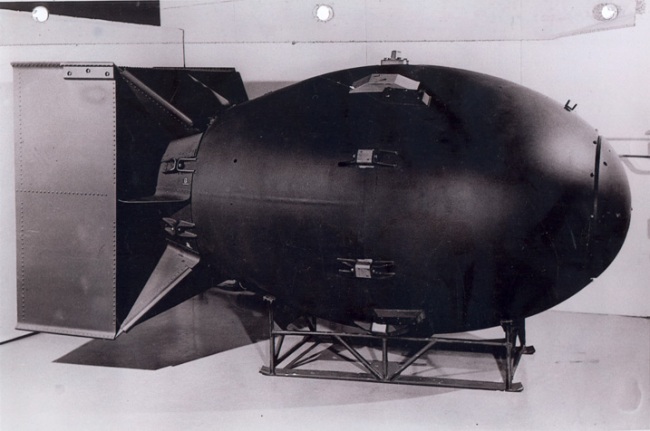
This is a photo of “Little Boy”
Summary of ” The Manhattan Project”
Early in 1939, the world’s scientific community discovered that German physicists had learned the secrets of splitting a uranium atom. Fears soon spread over the possibility of Nazi scientists utilizing that energy to produce a bomb capable of unspeakable destruction. Scientists Albert Einstein, who fled Nazi persecution, and Enrico Fermi, who escaped Fascist Italy, were now living in the United States. They agreed that the President must be informed of the dangers of atomic technology in the hands of the Axis powers. Fermi traveled to Washington in March to express his concerns on government officials. Einstein penned a letter to President Roosevelt urging the development of an atomic research program later that year. Roosevelt saw neither the necessity nor the utility for such a project, but agreed to proceed slowly. The building area was in Los Alamos, New Mexico. This project had about 2 billion dollars of research. The Manhattan project also employed 120,000 Americans. This was a secret project and everyone that worked for The Manhattan Project had to live at the Los Alamos camp site. By the summer of 1945, Oppenheimer was ready to test the first bomb. On July 16, 1945, at Trinity Site near Alamogordo, New Mexico, scientists of the Manhattan Project readied themselves to watch the detonation of the world’s first atomic bomb. The device was affixed to a 100-foot tower and discharged just before dawn. No one was properly prepared for the result. A blinding flash visible for 200 miles lit up the morning sky. A mushroom cloud reached 40,000 feet, blowing out windows of civilian homes up to 100 miles away. When the cloud returned to earth it created a half-mile wide crater metamorphosing sand into glass. A bogus cover-up story was quickly released, explaining that a huge ammunition dump had just exploded in the desert. For Truman, the choice whether or not to use the atomic bomb was the most difficult decision of his life. First, an Allied demand for an immediate unconditional surrender was made to the leadership in Japan. Although the demand stated that refusal would result in total destruction, no mention of any new weapons of mass destruction was made. The Japanese military command rejected the request for unconditional surrender, but there were indications that a conditional surrender was possible. On August 6, 1945, a plane called the “Enola Gay” dropped an atomic bomb on the city of Hiroshima. On August 9, a second atomic bomb was dropped on Nagasaki, where 80,000 Japanese people perished. They called the two bombs “Fat Man” and “Little Boy”. The United States dropped the two bombs 2 weeks before Japan was going to surrender. I don’t think it was right to drop the bombs. It whipped out the two whole cities and left a lot of after math. The bombs released larger amounts of radiation causing people who died from the blast; died from radiation poising or cancers years later. It also causes deformation in babies born a generation later and mutations in animals. When Japan surrendered to the Allies at the end of the long summer of 1945, Americans were ecstatic. Ticker tape parades were staged in nearly every town to welcome America’s returning heroes.
Introduction
My topic I’m going to talk about is World War II Manhattan project. I will be talking about the history and details about the Atomic bomb or also know as the Manhattan project. I will also be giving my opinion on if it was right to drop it on Nagasaki and Hiroshima (Japans big cities). I’ll also make a list of the people involved in making the atomic bomb.
The photo below is one of the Atomic Bombs named Fat Man.
